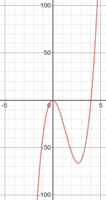I'm currently taking a course in (absolute) basics of mathematical proofs, and have this far been able to prove how a mapping (function) is surjection by taking an inverse of the function and then showing how putting the (right) inverse as input to the original function (ie. composing the function and its inverse), the result is identity.
This works just fine with linear functions, but gets (from my point of view at least) impossible with higher order polynomials with more than one term. For example, let f be a mapping from real numbers to real numbers such that f(x) = 7x^3 - 28x^2, and let us say that I'd like to show this function to be (or not to be) surjection.
It's clear that f is not an injection, since f(4) = 0 and f(0) = 0. Though this doesn't rule out a right inverse, and I think there is one, I have no idea how to find it.
However, I'm pretty sure there is a right inverse of f(x) = 7x^3-28x, so f should be surjection. Its graph hints at the same thing and I think 3. degree polynomial functions were said to be surjections. So, I think f is surjection, and would like to show it to be more than just a hunch.
Is there a way to prove from the definition of surjective (definition I'm working with: "if f: X -> Y is surjective, then for every y in Y there is an x in X for which f(x) = y") that the f above ie. f(x) = 7x^3 - 28x^2 is surjection?
In order to prove that the example f from above is surjection, I'd have to show that for any y in Y there is an x for which f(x) = y. The only way I can think of doing that is finding the (right) inverse of f(x) = 7x^3 - 28x^2 and then showing that composition of f and its inverse is the identity function.
With some algebra and remembering the zero product rule, I can be assure myself that the cubic function f I have cooked up has three real roots (x = 0 twice and x = -4 once). So, it seems to be the case that for some k in real numbers 7x^3 - 28x^2 - k = 0. And here I'd normally proceed by finding the inverse by solving for x, but this is exactly what I'd like to avoid (since I've got no idea how to get the right inverse of a cubic function).
This works just fine with linear functions, but gets (from my point of view at least) impossible with higher order polynomials with more than one term. For example, let f be a mapping from real numbers to real numbers such that f(x) = 7x^3 - 28x^2, and let us say that I'd like to show this function to be (or not to be) surjection.
It's clear that f is not an injection, since f(4) = 0 and f(0) = 0. Though this doesn't rule out a right inverse, and I think there is one, I have no idea how to find it.
However, I'm pretty sure there is a right inverse of f(x) = 7x^3-28x, so f should be surjection. Its graph hints at the same thing and I think 3. degree polynomial functions were said to be surjections. So, I think f is surjection, and would like to show it to be more than just a hunch.
Is there a way to prove from the definition of surjective (definition I'm working with: "if f: X -> Y is surjective, then for every y in Y there is an x in X for which f(x) = y") that the f above ie. f(x) = 7x^3 - 28x^2 is surjection?
In order to prove that the example f from above is surjection, I'd have to show that for any y in Y there is an x for which f(x) = y. The only way I can think of doing that is finding the (right) inverse of f(x) = 7x^3 - 28x^2 and then showing that composition of f and its inverse is the identity function.
With some algebra and remembering the zero product rule, I can be assure myself that the cubic function f I have cooked up has three real roots (x = 0 twice and x = -4 once). So, it seems to be the case that for some k in real numbers 7x^3 - 28x^2 - k = 0. And here I'd normally proceed by finding the inverse by solving for x, but this is exactly what I'd like to avoid (since I've got no idea how to get the right inverse of a cubic function).

